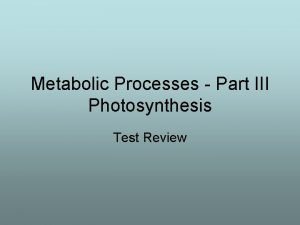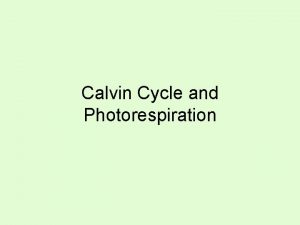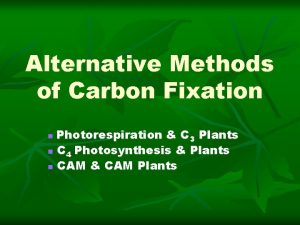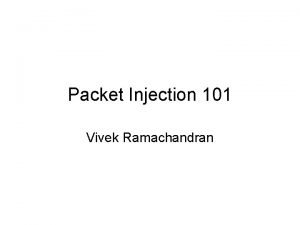Photorespiration PACKET 34 CHAPTER 10 Introduction In the





























- Slides: 29

Photorespiration PACKET #34 CHAPTER #10

Introduction In the 1960’s, it was discovered that illuminated plants consume and use O 2 and produce CO 2. With low CO 2 levels and high O 2 levels, this photorespiration overwhelms photosynthetic CO 2 fixation (light reactions + Calvin cycle).

Introduction II In a very lengthy and costly process, O 2 is converted into CO 2 and 3 phosphoglyceraldehyde. Photorespiration involves the use of three organelles Chloroplast Peroxisome Mitochondria Photorespiration also requires the use of ATP and NADPH. Reducing the number of those molecules readily available for the Calvin cycle (photosynthesis).

Introduction III �With higher levels of O 2, O 2 competes with CO 2 as a substrate for the enzyme rubisco (Ru. BP carboxylase/oxygenase). This is the foundation of photorespiration. O 2 binds to rubisco and starts the series of reactions that eventually lead to the production of CO 2 and 3 phosphoglyceraldehyde. �A wasteful process that undoes the some of the work of photosynthesis.

Introduction IV Plants can be divided into three categories based on how they deal with photorespiration. C 3 plants No mechanism developed to decrease photorespiration. C 4 plants CAM plants Both C 4 and CAM plants have mechanisms in place to decrease photorespiration.

Photorespiration & C 3 Plants

Photorespiration in C 3 Plants On dry, hot days in the presence of light C 3 plants close their stomata. This causes the plant to use O 2 retain as much H 2 O. O 2 binds to rubisco and starts the series of reactions. H 2 O is retained for use in the light reactions to fill the ATP and NADPH used as a result of photorespiration.

C 4 & CAM Plants Introduction C 4 and CAM plants have devised mechanisms that prevent/reduce the impact of photorespiration.

C 4 Plants & Photorespiration CONCENTRATING CO 2

Introduction I C 4 plants occur largely in tropical regions because they grow faster under hot and sunny conditions. C 3 plants live in cooler climates where photorespiration is less of a burden and less ATP is required to fix carbon.

Introduction II On a hot bright day, when photosynthesis has depleted the level of CO 2 at the chloroplast and raised that of O 2, the rate of photorespiration reaches the rate of photosynthesis. However, C 4 plants have leaves that are different anatomically to that of C 3 plants and have devised a mechanism to reduce the impact of photorespiration.

Introduction III Photorespiration is negligible in C 4 plants because the concentration of carbon dioxide is always high in the bundle sheath cells. C 4 plants “concentrate” CO 2.

C 4 Plants Process I Phosphoenol-pyruvate (PEP) Oxaloacetate PEP carboxylase adds CO 2 to PEP to produce Oxaloacetate Occurs in the mesophyll cell.

C 4 Plants Process II Oxaloacetate Malate dehydrogenase reduces oxaloacetate into malate. NADPH is used during this step.

C 4 Plants Process III Malate is transported from mesophyll cell into the bundle sheath cell.

C 4 Plants Process IV Malate Pyruvate Malic enzyme converts malate into pyruvate. Two byproducts are made. CO 2 • The CO 2 is now considered to be concentrated. NADPH • Both are used in the Calvin Cycle that occurs within the bundle sheath cell.

C 4 Plants Process V Pyruvate leaves the bundle sheath cell and enters the mesophyll cell.

C 4 Plants Process VI Pyruvate PEP Pyruvate-phosphate dikinase converts pyruvate into PEP.

C 4 Plants Process VII Process is repeated to concentrate more CO 2.

Additional Information on C 4 Plants. At lower light levels and temperature, C 4 plants will utilize the traditional C 3 pathway. Examples of C 4 plants Sugarcane Corn Crab grass.

CAM Plants & Photorespiration STORING CO 2

Introduction I CAM is an acronym for crassulacean acid metabolism. Examples Succulent plants {family Crassulaceae} Family Cactaceae Family Lilaceae Family Orchidaceae Many others in 25 families.

Introduction II CAM plants exhibit a pathway similar to C 4 plants and allow them to live in highly xeric conditions. CAM plants store CO 2 using a variation of the technique used by C 4 plants.

CAM Plants—Night CAM plants open their stomata at night. If these plants, living in the xeric conditions opened their stomata during the daytime, would lose large amounts of H 2 O through osmosis and then evaporation. PEP carboxylase fixes carbon at night in the mesophyll cells Stomata are open at night Minimizes water loss and allows the entry of CO 2 Calvin Cycle occurs during the daytime

CAM Plants—Night II PEP oxaloace tate malate PEP carboxylase and malate dehydrogenase fixes CO 2 at night in the mesophyll cells. Malate is stored in vacuoles.

CAM Plants—Daytime I During the daytime, while the stomata is closed, malate is converted into pyruvate in the bundle sheath cell. This allows the production of CO 2 is used to drive the Calvin cycle in the bundle sheath cell.

Review

Review Types of plants C 3 C 4 Concentrate CO 2 in the bundle sheath cells. CAM Store CO 2 in the form of malate by having the stomata only open at night.

Homework Assignment What are some of the similarities, and differences, between C 4 and CAM plants?
 Photorespiration occurs principally because of
Photorespiration occurs principally because of Introduction to cisco packet tracer
Introduction to cisco packet tracer Sexual reproduction
Sexual reproduction Hát kết hợp bộ gõ cơ thể
Hát kết hợp bộ gõ cơ thể Lp html
Lp html Bổ thể
Bổ thể Tỉ lệ cơ thể trẻ em
Tỉ lệ cơ thể trẻ em Voi kéo gỗ như thế nào
Voi kéo gỗ như thế nào Tư thế worm breton
Tư thế worm breton Chúa yêu trần thế alleluia
Chúa yêu trần thế alleluia Các môn thể thao bắt đầu bằng tiếng đua
Các môn thể thao bắt đầu bằng tiếng đua Thế nào là hệ số cao nhất
Thế nào là hệ số cao nhất Các châu lục và đại dương trên thế giới
Các châu lục và đại dương trên thế giới Công của trọng lực
Công của trọng lực Trời xanh đây là của chúng ta thể thơ
Trời xanh đây là của chúng ta thể thơ Mật thư anh em như thể tay chân
Mật thư anh em như thể tay chân Làm thế nào để 102-1=99
Làm thế nào để 102-1=99 độ dài liên kết
độ dài liên kết Các châu lục và đại dương trên thế giới
Các châu lục và đại dương trên thế giới Thể thơ truyền thống
Thể thơ truyền thống Quá trình desamine hóa có thể tạo ra
Quá trình desamine hóa có thể tạo ra Một số thể thơ truyền thống
Một số thể thơ truyền thống Bàn tay mà dây bẩn
Bàn tay mà dây bẩn Vẽ hình chiếu vuông góc của vật thể sau
Vẽ hình chiếu vuông góc của vật thể sau Thế nào là sự mỏi cơ
Thế nào là sự mỏi cơ đặc điểm cơ thể của người tối cổ
đặc điểm cơ thể của người tối cổ Thứ tự các dấu thăng giáng ở hóa biểu
Thứ tự các dấu thăng giáng ở hóa biểu Vẽ hình chiếu đứng bằng cạnh của vật thể
Vẽ hình chiếu đứng bằng cạnh của vật thể Vẽ hình chiếu vuông góc của vật thể sau
Vẽ hình chiếu vuông góc của vật thể sau Thẻ vin
Thẻ vin





















































